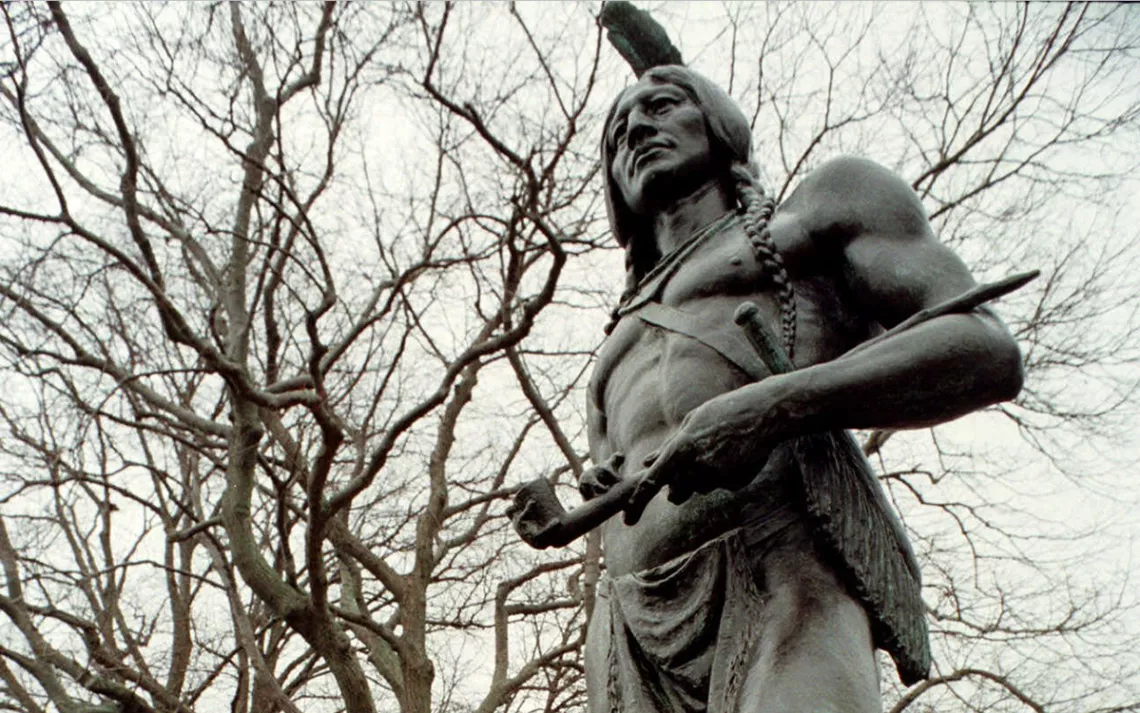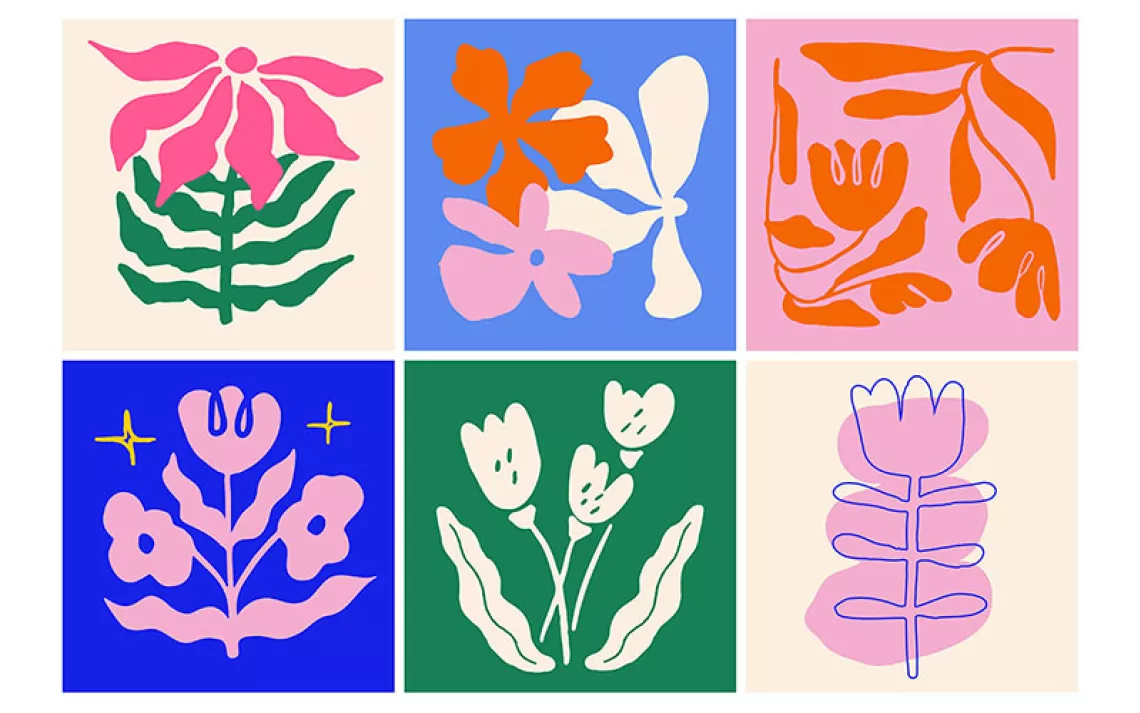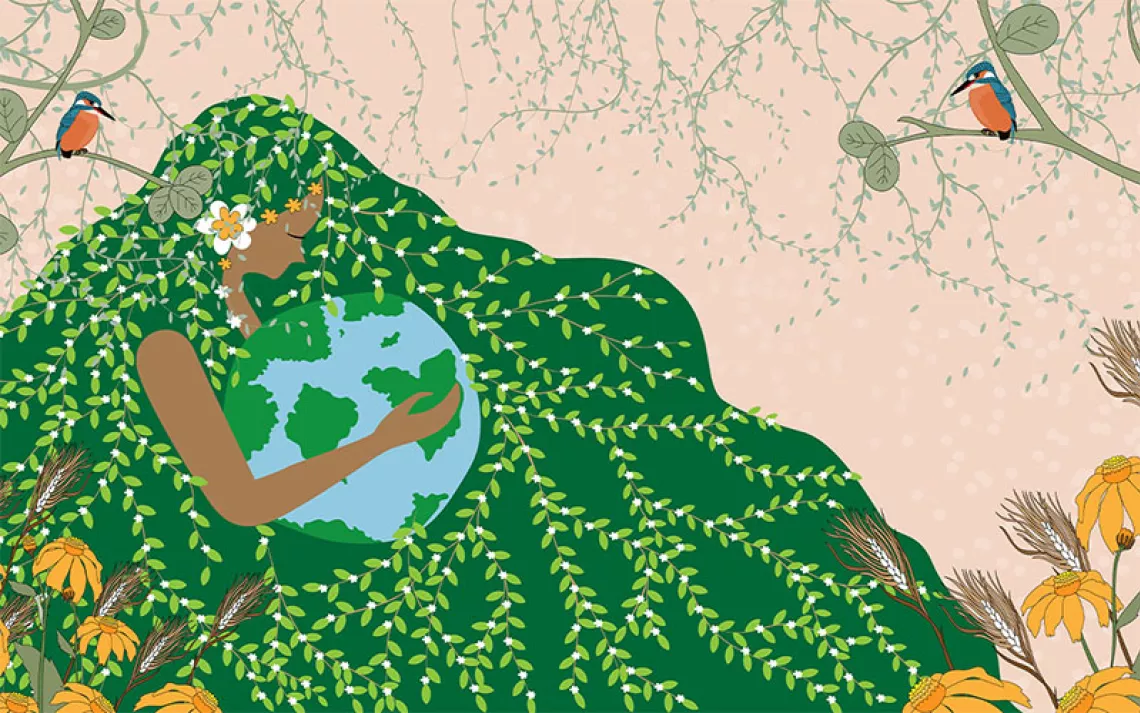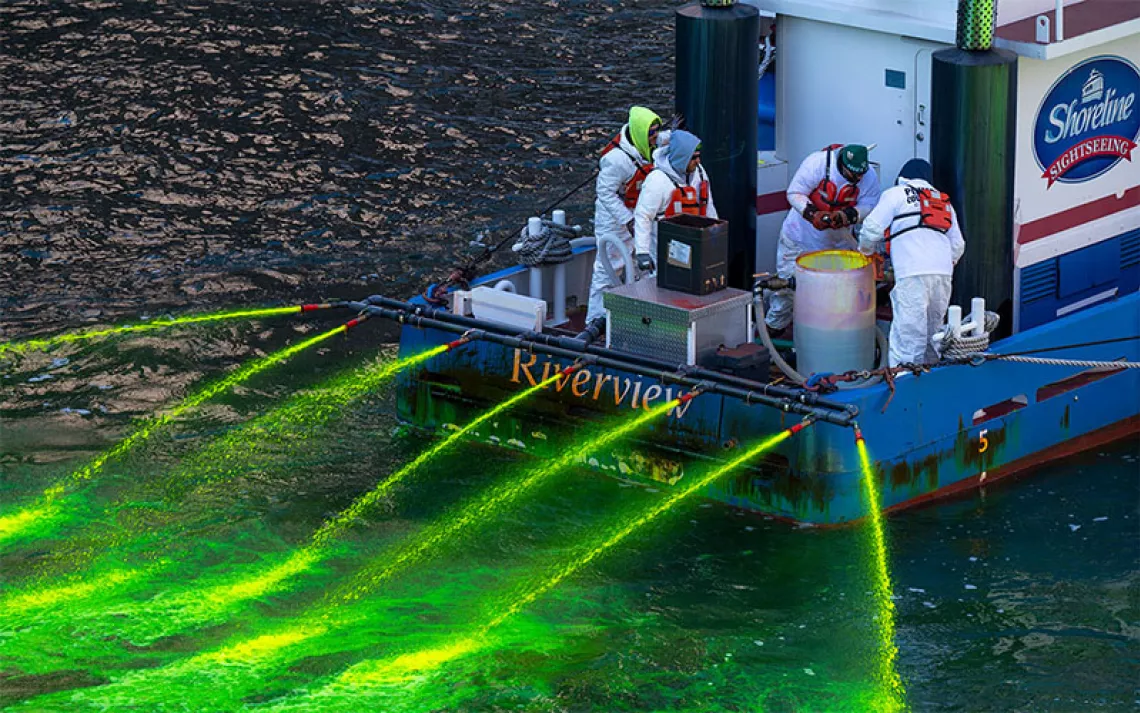Celebrate Indigenous History This Thanksgiving
Here's how to authentically honor the holiday

Photo by Neal Hamberg/Associated Press
A version of this article was originally published November 20, 2018.
Modern Thanksgiving celebrations are marked by warm gatherings with loved ones (family- or Friendsgiving-style), autumn-themed foods, and maybe a few words about good things in life to be thankful for. There typically isn’t much dinner chat about 17th-century pilgrims feasting with friendly Native Americans. In fact, the establishment of Thanksgiving as a federal holiday in 1863 wasn’t so much intended to honor said colonial gathering, but rather as a morale-boosting gesture on President Abraham Lincoln’s part to foster patriotism and commemorate Civil War veterans.
The pilgrim–Native American story is mostly relegated to early-grade history lessons and school plays, with all the messy genocidal bits glossed over with turkey feathers. In reality, the story of the first Thanksgiving at Plymouth Rock is complicated and political, and paved the way for European colonizers to capitalize on uneasy truces with the Algonquin tribes of the northeastern United States. For many people of Native American descent, celebrating Thanksgiving would be akin to feting the arrival of Dutch slavers in Africa in the 17th century. “There’s just no way to celebrate Thanksgiving without celebrating Native genocide,” says Jen Deerinwater, a citizen of the Cherokee Nation of Oklahoma who writes for the Indigenous storytelling platform Crushing Colonialism. Deerinwater notes that Thanksgiving caps a trifecta of fall traditions that mock or glorify Indigenous oppression: It follows football season’s parade of stereotypical mascots and Columbus Day. “Fall in general is a tough time as an Indigenous person, because it’s just back-to-back degradation.”
So how to observe the holiday in ways that support Indigenous communities, that acknowledge the tribal land rights and sovereign agency of Indigenous nations? To start, it’s crucial to learn the true, ugly story of that fateful gathering in 1621.
The relationship between the pilgrims and members of the Wampanoag tribe—who inhabited the area of Plymouth, or Patuxet, for an estimated 10,000 years before the pilgrims’ arrival—involved a tense exchange of knowledge and goods. In those days, Native tribes often initiated interactions with colonizers, primarily as a strategic deterrent to kidnapping and enslavement: All along the Northeast coast, tribes including the Wampanoag, Massachusett, Abenaki, Narragansett, and Nauset had become very familiar with the pitfalls of trusting European sailors after a century of dealing with them. Contrary to the traditional narrative, the Wampanoag did not approach the Mayflower pilgrims from a place of blind altruism. Rather, the decision to initiate an alliance was political: The Wampanoag, who had been decimated by smallpox (brought by European sailors), were in danger of being overrun by the rival Nauset tribe. Their pact with the pilgrims served as a defense strategy to gain guns and weaponry, and a foothold in the tribe’s former territory.
One of the most misleading notions perpetuated by the Thanksgiving narrative of pilgrims as peaceful colonists—or even stories that acknowledge the pilgrims as racist opportunists—is that the Indigenous population was composed of innocent patsies, powerlessly swept up in a wave of European ambition. In fact, the Algonquin tribes masterfully controlled where settlers could make landfall, what they could trade for, and how long they were allowed to settle without being attacked by the tribes whose land they occupied (usually, not very long). According to Charles C. Mann, author of 1491: New Revelations of the Americas Before Columbus (Knopf, 2005), “Despite European guns, the Indians’ greater numbers, entrenched positions, knowledge of the terrain and superb archery made them formidable adversaries,” he writes. Pilgrims’ accounts of Indigenous leaders repeatedly describe them as mythically robust, striking of countenance, and extremely healthy. The settlers, by contrast, were often malnourished, deficient in hygiene, and—as a population largely made up of common citizens seeking religious independence, with little knowledge of European farming practices—resistant to teaching. The settlers were “utterly dependent,” Mann documents, upon Indigenous charity and good faith.
The Thanksgiving meeting of 1621, then, followed decades of wary trade, occasional enslavement, disease, and frequent skirmishes between the area’s Native inhabitants and its European colonizers. And Squanto, the conveniently English-speaking Native American who helps out the starving pilgrims in traditional American retellings, did not simply pop out of the forest to offer his aid.
A few years prior, Tisquantum, whose name would later get shortened to Squanto, had been brutally betrayed and sold into slavery by the explorer Thomas Hunt (Captain John Smith’s second-in-command). After trying to sell his human cargo, Hunt was detained in Spain, and Tisquantum remained in England for several years, where he learned to speak English. After many false starts at attempts to return home, Tisquantum eventually bartered passage aboard a ship bound for what is now Maine. What he found upon his return was utter devastation: The hundreds of miles of coastal communities that had previously made up the thriving Wampanoag Confederacy were completely abandoned. Piles of bleached bones littered every village. While Tisquantum was detained in Europe, the Native communities had been decimated by an epidemic that is now thought to be smallpox, brought by French colonizers in 1616. Over a period of three years, the pestilence, known as the "Great Dying,” had traveled down the coast and wiped out an estimated 90 percent of the Wampanoag nation, which had previously been 20,000 strong. Less than a thousand remained by the 1621 gathering.
The depletion of Wampanoag territory presented an opportunity for European colonizers—they pounced on the newly available and formerly hostile land. Who were the pilgrims, exactly? An expedition of British colonists, seeking to escape King James’s rule by sailing to the area of Cape Cod, which was granted to them via the Virginia Company of Plymouth. Nearly half of the crew died en route; many more would die over the following winter due to starvation and cold. The reduced Wampanoag tribe, held together by their leader, or sachem, Massasoit, allowed the colonizers to build their community through the winter, aided by information from Tisquantum, who had been captured and was warily serving as go-between for European exchanges. Under threat by the Nauset, Massasoit only decided to send a delegation to the pilgrims as a strategy of last resort.
The peace brought about by that alliance lasted 50 years, but from the perspective of the increasingly threatened tribes, it was borrowed time. Emboldened by the success of the Plymouth Pilgrims’ survival, tens of thousands of European settlers descended on New England, colonizing the emptied Wampanoag territory and taking advantage of similar alliances borne from tribal rivalries. By 1675, the pact with the pilgrims at Plymouth had all but disintegrated. The Europeans gained enough numbers in New England to establish a military foothold, and the northeastern Algonquin tribes were nearly wholly eliminated by war, disease, or enslavement.
The modern Thanksgiving celebration doesn’t have to memorialize a history of colonial genocide. It can present a learning opportunity, and moreover, an opportunity to act on behalf of the Indigenous communities whose sovereignty remains challenged today. “One way to take accountability for settler colonialism is to practice land acknowledgment,” suggests Jade Begay, a filmmaker of Diné and Tesuque Pueblo heritage who serves as campaign director at For the Wild, an ecological Indigenous storytelling collective. Land acknowledgment, which is the practice of verbally, deliberately acknowledging Indigenous territory in the context of an event or gathering, is another means of recognizing that one is inhabiting stolen land. “Everybody needs to remember that they’re on some tribal nations’ land, and they're able to be on that land because of genocide,” Deerinwater says. For insights into how to acknowledge and identify the land where you live, check out this map of tribal territories—though unofficial, it is crowdsourced by Indigenous representatives throughout the United States.
Communal remembrance of tribal history is another alternative: the United American Indians of New England recognize Thanksgiving as a Day of Mourning, established in 1970 to honor the memory of ancestral lives brutally taken. Other Indigenous communities seek to turn the traditional narrative on its head by using the day to celebrate the endurance of modern Indigenous communities. For many others, it is easier to simply refuse to give the day any significance and instead practice individual forms of self-care.
A perhaps more proactive way of honoring the sacrifices of tribal communities is to actively support local Indigenous groups in defending their land. Learn what issues are presently affecting the tribes in your area and how you can help them through community action and/or by spreading awareness. Resources like Indigenous Rising, Indian Country Today, and Indianz.com track Indigenous news and on-the-ground developments of those tribal issues that could benefit from community support.
“Thanksgiving is a good opportunity for non-Native folks to start building lasting relationships with their local Indigenous nations,” says Deerinwater. “One suggestion I give is to donate the money they would’ve spent on a Thanksgiving meal to Native organizations and causes, if it’s within their means. Keep reaching out and ask to help; if people keep showing up, we notice that, and eventually we’re going to see you as an ally.”
 The Magazine of The Sierra Club
The Magazine of The Sierra Club



